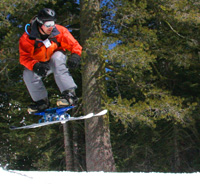Deuce Snowboards Does Extreme Product Design
 The invention of the snowboard threw the downhill snow sports world onto a whole new ride. But the snowboard hasn't had a significant advance since metal edges some 20 years ago. Founded in 2005, Deuce Snowboards (www.deucesnowboards.com) broke into the established market by giving the sport a new edge.
The invention of the snowboard threw the downhill snow sports world onto a whole new ride. But the snowboard hasn't had a significant advance since metal edges some 20 years ago. Founded in 2005, Deuce Snowboards (www.deucesnowboards.com) broke into the established market by giving the sport a new edge.Todd Belt, Deuce Snowboards' founder and chief executive officer, first found inspiration on a chairlift above a black diamond run as he watched an expert snowboarder hit a downed skier. Belt's engineering mind turned on. From his skiing experience, Belt knew he would have had no problem avoiding that collision. The simple difference between skiing and snowboarding is the benefit of two edges for tighter turns and faster stops. From his snowboarding experience, he knew of its excitement and popularity. Could the best of both be combined?
What started as a mental exercise quickly led to something more. Belt says, "I originally started out playing with the idea for the multi-edge snowboard just to see if it could be done. As the design started to materialize, the concept quickly turned from engineering experiment to viable product."
Belt went on to invent an entirely new category of snowboard, termed the multi-edge snowboard (MES) because it is made of two smaller boards that are connected by a riding platform that fits standard snowboard equipment.
A Trial Run
To support the detailed development and launch of the product, 3D CAD would be essential. PTC CoCreate (www.ptc.com) was a fit with Belt's innovation process, which started with a first-generation of product that Deuce Snowboards prototyped virtually within the world of 3D CAD. A second generation of product was test marketed on the slopes of Lake Tahoe destination resorts.
"Just standing in line to buy a lift ticket drew a crowd of high school students anxious to know what we had with us," says Belt. "I quickly learned that being 'sick' is now a very good thing. The response that I have received on the slopes is much of what keeps me energized day by day."
Belt gathered market reaction and design feedback on the slopes by having different snowboarders ride the prototype. Experienced snowboarders adjusted to the differences by the end of one run.
As Belt worked through development, the design progressed organically to new information coming in. It evolved by simply adding or subtracting material in different locations based on engineering analysis or field testing.
PTC CoCreate delivers the full power of 3D CAD design software that evolves product designs in response to unexpected changes and new information throughout the innovation process. Virtual prototypes of early designs cut the time and expense of unneeded physical prototypes.
"I would take a copy of an existing part that was close to what I wanted and change it," says Belt. "Designer Modeling makes changes easy for complex parts as the design progresses from variation to variation, because you don't have to deal with trying to rebuild from some point in a history tree."
The most significant improvement is set to appear in the third generation of product, which was developed over the past off-season and currently scheduled for early production runs. This patent pending product will hit the slopes in the coming months as multi-edge snowboarding steps into winter sports.

